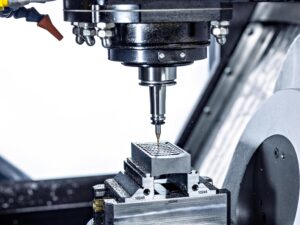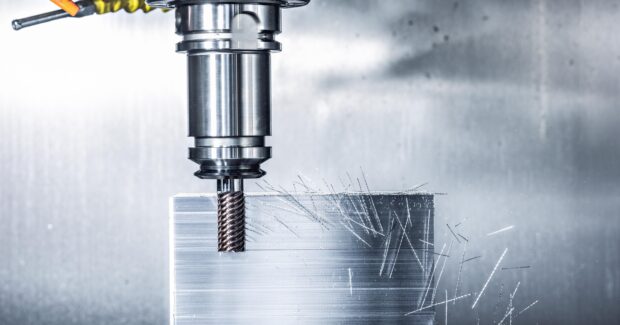Sizing Up the Right Tool Holder
Applications dictate the perfect fit and prevent costly problems down the road.
Posted: July 22, 2023

It might be common practice for shops to employ an “if the tool fits, load it” strategy and use whatever tool holder or collet they have for a particular production run. However, that one-size-fits-most philosophy can cost manufacturers time in reworking scrap and money in lost production due to prematurely worn or broken tools.
Using the right tool holder for the job at hand is critical to the process. When it comes to the extremes of very large and very small tools, there is more to the question than size alone when considering tool holder selection, and for some applications the answer is counterintuitive at first glance. Very tiny tools like those used for micro-boring in the 0.010” diameter spectrum and larger diameter tools approaching 1.0” diameters both pose unique challenges.
Tool Holder Rigidity
Though it might seem contradictory, a tool holder can be too rigid for certain applications, especially those involving small tools. Loading a micro-reamer into a large, burly tool holder is like performing an appendectomy with a jackhammer. The job might get done but there is more than a good chance for trouble and an unacceptable amount of damage.
The problem lies in the large tool holder’s rigidity, which is a direct result of its mass. A large tool holder is too rigid to absorb and damp the inevitable vibration that results at the tool during any manufacturing process. Like a dog whistle’s relation to the human ear, tiny tools machining small, delicate features produce vibration frequencies to which a large tool holder cannot respond. Whatever vibration damping characteristics the larger tool holder has will not be triggered, and the vibration generated at the cutting edge will not be absorbed. As a result, tolerances and part surface finishes suffer, and the risk of tool breakage increases.
A large collet like the REGO-FIX ER32, for example, will effectively hold a .010” diameter end mill to perform a roughing application; however, it will not be sufficiently forgiving because of its mass. The collet mass-to-tool-size disparity prevents the ER32 from absorbing and damping the vibration created at the end mill, making the tool the weak link in the chain and risking tool breakage in the process.
A more suitable solution would be either an ER11 or powRgrip PG10 that has less mass, is less rigid and more forgiving with better damping qualities. Collets of that size respond better to vibrations created in micro-processing. Vibration is absorbed and damped by and through the entire system, maintaining an acceptable total indicated runout (TIR), enhancing tool life, and improving feed rates for better performance.
For small tool sizes such as a 0.010” diameter drill with a 0.125” diameter shank, the powRgrip collet line provides more repeatability and easier set up than other tool holders. Designed for both roughing and finishing operations, powRgrip enables tool changeouts in less than 10 seconds and performs with less than 3 microns of TIR. Runout is critical in small-tool machining, not only because of the tolerances involved, but for matters of tool wear. Smaller tools with smaller cutting edges and flutes are more susceptible to wear as runout increases.
At the other end of the spectrum, when tools and tool weights get hefty for aggressive machining, the tool holder can be neither too big nor too rigid. Rigidity and clamping force become the prime considerations — even over TIR — for heavy, robust applications. Where a tool holder’s clamping force parameters are outweighed by its damping characteristics in small tool cutting, high power/torque machining will require a holder such as the secuRgrip collets that are specifically designed for the heaviest machining applications.
Tool walking during the cutting process can also be affected by tool holder size and selection. Tool length and workpiece material are elements that factor into the tool holder equation. As the distance between the spindle and cutting edge increases, so, too, must tool holder rigidity, demanding more size and mass. Long tool lengths produce greater amounts of compound TIR, and an appropriate tool holder for the setup can prevent tools from walking during the machining process. Workpiece material, especially those with differing densities, can also affect the decision.
The Art of Balancing: Machining Intuition
Between the two extremes of large and very small tools lies the middle ground where needs are balanced with experience and intuition through trial and testing. Unfortunately, there are no hard and fast rules.
Every machine along with its fixturing and physical characteristics are different. In lieu of an expensive trial and error process, experienced operators become invaluable. They know and understand a particular machine’s traits and how it will react to the introduction of variables, which, in turn, helps establish a baseline for application setups.
Strategies
Various production environments also impact tool holder sizing and selection. Production shops that focus exclusively on one or a limited range of parts have a keen interest in refining their cuts to find the most cost-efficient and accurate method of making their parts. As such, they are more likely to test a broader variety of tool holders to find what works best for their application. Low-volume/high-mix job shops, on the other hand, generally tend to use tool holders they know will get the job done.
In those environments, versatility is a key factor for deciding on tool holder inventory. While there might be an inclination to default to larger tool holders because of the broad range of tool sizes they can accommodate, the discussion of vibration damping should mitigate against that action.
Shops may consider hydraulic tool holders, but with larger tool sizes and vigorous/heavy milling operations, those types of holders tend to sacrifice rigidity. Larger tool sizes limit the option of heat shrink-type holders. Additionally, those holders require a holder for every tool in the shop, which increases tooling inventory costs.
A sweet spot; however, is the REGO-FIX powRgrip system and ER collets that accommodate tool sizes ranging of 0.2 mm-to-36 mm and 0.2 mm-to-25.4 mm, respectively, and have been shown to be consistently accurate and highly versatile in terms of application and use. Keeping a flexible, functional inventory of tool holders allows shops to better balance competing considerations for rigidity, clamping force and TIR for various applications.
Subscribe to learn the latest in manufacturing.






